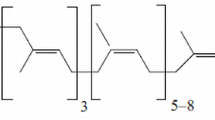Abstract
Vegetative cells as well myxospores ofMyxococcus xanthus have shown anticomplementary activity and the capacity to be used as active agents in the skin preparation of the Shwartzman reaction and in its intravenous induction. These endotoxin-like properties were not extractable by the hot phenol-water methods. Our results suggest the presence of a lipid A analog in both vegetative cells and myxospores, and emphasize the difficulty of lipopolysaccharide detection; this is perhaps a consequence of a developing associated change in polysaccharide moiety of the myxobacterial lipopolysaccharides; this may be the basis of the special immunomodulation pattern shown byM. xanthus myxospores.
Similar content being viewed by others
Literature Cited
Butler RC, Nowotny A, Friedman H (1981) Induction for immunomodulatory factors by LPS and nontoxic derivatives. In: Friedman H, Klein TW, Szentivanyi A (eds) Immunomodulation by bacteria and their products. New York: Plenum, pp 181–197
Diamanstein T, Keppler W, Blitstein-Willinger E, Benafrain S (1976) Suppression of the primary immune response in vivo to sheep red blood cells by B cells mitogens. Immunology 30:401–407
Dworkin M (1962) Nutritional requirements for vegetative growth ofMyxococcus xanthus. Bacteriol 84:250–257
Dworkin M, Gibson SM (1964) A system for studying microbial morphogenesis: rapid formation of microcysts inMyxococcus xanthus. Science 146:243–244
Dworkin M, Neiderpruem DJ (1964) Electron transport system in vegetative cells and microcysts ofMyxococcus xanthus. J Bacteriol 87:316–322
Galanos C (1975) Physical state and biological activity of lipopolysaccharide: toxicity and immunogenicity of the lipid A component. Immunobiology (Stuttgart) 149:214–229
Galanos C, Lüderitz O (1976) The role of the physical state of lipopolysaccharide in the interaction with complement. Eur J Biochem 65:403–408
Haskä G, Noren B (1967) Growth and enzymes activity ofMyxococcus virescens in liquid medium. Physiol Phant 20:851–861
Hurvell B, Lindberg AA (1973) Serological cross-reactions between differentBrucellas species andYersinia enterocolitica. Acta Pathol Microbiol Scand [B] 81:113–119
Ito M (1985) Shwartzman reaction in germfree rabbits. Infect Immun 50:33–35
Kaiser D, Manoil C, Dworkin M (1979) Myxobacteria: cell interaction, genetic and development. Ann Rev Microbiol 33:595–639
Leong D, Diaz R, Milner K, Rudbach J, Wilson JB (1970) Some structural and biological properties ofBrucella endotoxin. Infect Immun 1:174–182
Luderitz O, Risse HJ, Schulte-Holthausen H, Strominger JL, Sutherland IW, Westphal O (1965) Biochemical studies of the smooth-rough mutation inSalmonella minnesota. J Bacteriol 89:343–354
Moreno E, Bernan DT, Boettcher LA (1981) Biological activities ofBrucella abortus lipolysaccharides. Infect Immun 31:362–370
Reitschel E, Galanos C, Luderitz D (1975) Structure endotoxicity and immunogenicity of the lipid A component of bacterial lipopolysaccharides. In: Schlessinger D (ed) Microbiology-1975. Washington DC: American Society for Microbiology, pp 307–314
Ruiz C, Ruiz-Bravo A, Alvarez de Cienfuegos G, Ramos-Cormenzana A (1985) Immunomodulation by myxospores ofMyxococcus xanthus. J Gen Microbiol 131:2035–2039
Sutherland IW (1976) Novel surface polymer changes in development ofMyxococcus spp. Nature 259:46–47
Sutherland IW, Thomson S (1975) Comparison of polysaccharides produced byMyxococcus strains. J Gen Microbiol 89:124–132
Westphal O, Lüderitz O, Bister F (1952) Über die Extraktion von Bakterien mit Phenol/Water. Z Naturforsch 7b: 149–155
Author information
Authors and Affiliations
Rights and permissions
About this article
Cite this article
Ruiz, C., Ruiz-Bravo, A. & Ramos-Cormenzana, A. Endotoxin-like activities inMyxococcus xanthus . Current Microbiology 15, 343–345 (1987). https://doi.org/10.1007/BF01577592
Issue Date:
DOI: https://doi.org/10.1007/BF01577592




